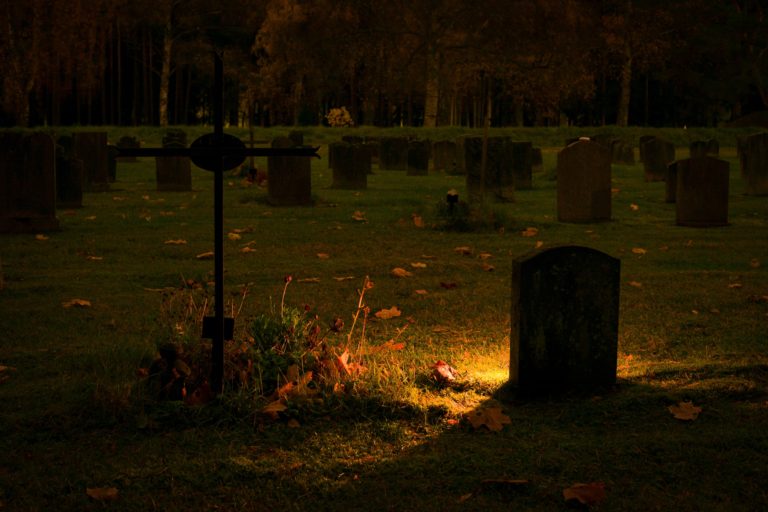Ada Witch
The tale of the Ada Witch is a short one. As the story goes, a married woman met with her lover in a park one night. On suspicion that she was cheating, her husband followed her, and after waiting for proof of her adultery he confronted the two. The story goes that things get heated quickly and the husband soon killed the wife, which caused the lover to get confrontational as well. In the end the husband killed both his wife and her lover, before dying himself due to his own wounds in the fight. While no official police reports have been found that coincide with the events of the wife’s death, people say that you can still see her ghost hanging around, either in Seidman Park where she died, Honey Creek Road where her body was found, or in Findlay Cemetery where she was buried. Those that have seen her report cold spots, and tapping on their shoulders, as well as shrieking, weeping, and audible footsteps in the areas she tends to frequent. Even though she may not be a witch, people call her that for the eerie mists she creates when you see her.

Mishipeshu
A Jesuit missionary named Claude Dablon told a story about four Ojibwa Indians who embarked on a journey to the home of Mishipeshu to take some copper back to their home, and use it to heat water. The very second they pushed off and backed into the water with their canoe, the eerie voice of the water panther surrounded them. The water panther came growling after them, vigorously accusing them of stealing the playthings of his children. All four of the Indians died on the way back to their village, the last one surviving just long enough to tell the tale of what had happened in his final moments before he died.
The Mishipeshu often called the Underwater Panther looks like a mix between a cougar and a dragon ranging between the size of a lynx and the size of a small mountain. This creature comes from Indiginous tales, and is regarded as the protector of the Great Lakes. It tends to look different in different tales, often it has a prehensile tail sometimes made of copper that helps it swim in the choppy waters of Lake Superior. It also boasts large horns or antlers and scales along its back in a saw-tooth pattern, however the rest of its body is covered in fur.
Mishipeshu is known to hoard the large amounts of copper that is in the Great Lakes Region. Indiginous people had been mining the copper long before any type of settlers came to America. In the 17th century when missionaries for the Society of Jesus came to Michigan and surrounding areas it had become taboo and even forbidden to take the copper from the lakes. It was even worse to take from Michipicoten Island (located inside the Canadian border in Lake Superior) which was regarded as Mishipeshu’s home.
I found one story about Mishipeshu from a Jesuit missionary named Claude Dablon. I’m not sure how accurate it is as most Indigenous people did not go to the lakes to take copper but the story still stands as a warning. According to Claude, four Ojibwa Indians embarked on a journey to Mishipeshu’s home to take some copper back to heat water. The second they took off and were fully surrounded by water they heard Mishipeshu. It accused them of stealing the playthings of its children. Unfortunately all four tribesmen died on their way back to their village, the last one surviving long enough to tell their tale.

Melon Heads
The Melon Heads of Michigan are said to be runaways from the Junctions Insane Asylum near Felt Mansion. The story goes that these runaways were children that had hydrocephalus, which is a condition where fluid accumulates in the brain and enlarges the head, sometimes causing brain damage. These children had undergone physical and emotional abuse while at the asylum and had become uncontrollable and feral while under care of physicians. They were released to the woods surrounding the asylum under the assumption that they would most likely die, however they did not and lived in the Felt Mansion instead. These children apparently devised a plan while they stayed there and went back to the asylum to bring about a twisted sense of justice for their mistreatment. The stories say they killed a doctor and with no place to hide the body they cut it up into small pieces and hid them around the mansion. Rumors say that years later teenagers who broke into the mansion saw ghosts of the children and shadows of the doctor coming through the light of an open door. The Allegan County Historical Society states that the asylum never existed, though it was a prison at one point. In 2011 there was a movie simply called The Melonheads based off of this legend.

Nain Rouge
The Nain Rouge, also called the Red Dwarf or ‘The Demon of the Straight’ is a legend based in Detroit Michigan. He was first spotted by the founder of Detroit, Antoine de la monthe Cadillac who found him on the bank of the Detroit River. Upon startling him Nain Rouge jumped up and brandished a stick at him, also startled Cadillac beat at the creature with his sword until it ran away. After this experience Cadillac lost his entire fortune, went back to France, lost his trade monopoly, and had lost all benefits that accompanied him throughout his lifetime. In 1805 Nain Rouge was spotted racing through the streets days before the city was burned to the ground in the Great Fire of 1805, fortunately there were no casualties during this fire. It was spotted again in 1812 when the British began bombing American forces at Fort Detroit, eventually when General Hull finally accepted the British unconditional surrender he reported seeing the Nain Rouge laugh at him as the fog cleared. It has also been seen in 1967 during the police raid that sparked the Race Riots, and then again in 1977 by Detroit Edison lineman the day before a historic ice storm hit the city and left roughly 400,000 citizens without power. The linemen said that the Nian Rouge had crawled up a utility pole before they yelled at it to stop, they reported that it reached the top of the pole and dropped to the ground without a scratch, leered at them and ran away. Each spring Detroit puts on a parade called Marche du Nain Rouge in the hopes to banish it for another year, unfortunately for the past two years it has been cancelled because of covid restrictions.

Michigan Dogman
Michigan’s Dogman is reported to be a bipedal dog-like creature with the head of a dog and the body of a man. It was first reported in 1887 by two lumberjacks that described the creature, as well as being spotted in Wexford county where it terrorized residents. According to legend the Dogman will appear to humans in a ten year cycle that falls on years ending in the number seven. The Dogman has also been referenced in pop culture, a song being made about him by a Traverse City DJ named Steve Cook. The song is called “the Legend” which recounts the Dogman’s historical whereabouts, describing horrible events in the process. Saying things such as frightening a team of horses to death, tormenting a schooner’s crew, and peering into a hippie’s van in the 1960’s.
